
WASHINGTON — The Senate Banking Committee will hold a hearing next month on the creation of a national infrastructure bank, chairman Christopher J. Dodd said yesterday.
The Connecticut Democrat joined a coalition of infrastructure bank proponents, including Pennsylvania Gov. Edward G. Rendell, at a press conference here to urge Congress and the Obama administration to create the bank.
The group, led by a group called Building America’s Future, also sent a letter last week to the president asking for his fiscal 2011 budget to provide at least $10 billion to capitalize a national infrastructure bank. The budget request is to be released early next month.
However, a number of hurdles stand in the way of the bank’s creation. House and Senate members decided not to provide conditional funding for a national infrastructure bank late last year, saying that the bank should first be created through the usual authorization process.
A multi-year transportation authorization bill has not advanced beyond the subcommittee level in the House and is expected to be delayed through this year. Questions also remain about the composition of the bank, how it would be capitalized and sustained, and who would choose the slate of projects to be financed.
“We’re looking for presidential leadership,” Rendell said. “America needs a variety of methods — action by the government and private sector, current and new revenues, and federal leadership and local innovation — to repair and modernize our nation’s infrastructure.”
The advocates argued that the bank would help create jobs and generate economic activity, echoing the job-creation angle taken recently by similar groups.
“Any strategy for long-term job creation and economic growth must be centered on moving from a consumption economy to an economy that puts people to work building things again,” said Rep. Rosa DeLauro, D-Conn.
Rendell praised the creation of the Transportation Investment Generating Economic Recovery grants. The so-called TIGER grants have been wildly popular and currently are the only vehicle for multi-state surface transportation projects.
“But after the stimulus is done, we have no vehicle” for those kinds of projects, the Democratic governor said. “The infrastructure bank is absolutely perfect for that.”
He said the infrastructure bank could be used to make annual payments on public-private partnership leases, provide credit assistance for Transportation Infrastructure Financing and Innovation Act loans, and to provide private-activity bonds and possibly Build America Bonds. Rendell added that the bank should have independent bond authority.
As envisioned by proponents, the bank would be a financing and funding vehicle for many different types of infrastructure — highways, bridges, ports, passenger rail, freight rail, water and sewer treatment plants, broadband, and schools, among other projects.
“A national infrastructure bank with a strong water component should be among the options considered by Congress and the administration to meet this need,” said Dan Hartnett, legislative affairs director for the Association of Metropolitan Water Agencies. “To be most effective, the bank should target assistance to large water projects of regional or national significance — thus giving urban water utilities a fair chance at competing for funds.”
The coalition also included two of the largest industry groups, the American Road and Transportation Builders Association and the American Association of State Highway and Transportation Officials.
Later in the day, the American Public Transportation Association hosted a conference call with reporters in anticipation of the Federal Railroad Administration’s forthcoming announcement of how it will use the $8 billion of high-speed rail funds made available by the American Recovery and Reinvestment Act.
“Financing is not funding,” Art Guzzetti, APTA vice president of policy, said in his argument for a longer-term federal high-speed rail program. “You can’t do financing without funding.” One of the challenges states and localities will face in developing a high-speed rail network is “what kind of regional authorities will be created” to facilitate the network, he said.





